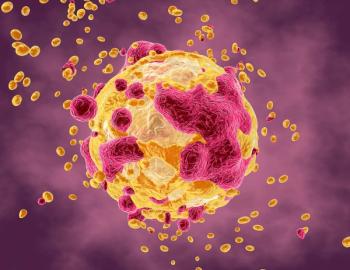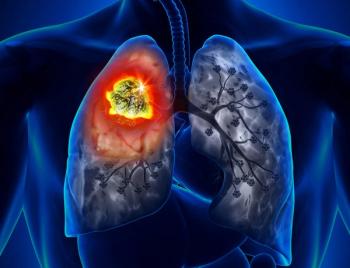
Oncology NEWS International
- Oncology NEWS International Vol 9 No 6
- Volume 9
- Issue 6
Greater HPV Persistence in HIV+ Women in Southeast US
SAN DIEGO-Human immunodeficiency virus (HIV)-infected women from the southeastern United States are more likely to have contracted HIV through heterosexual contact, to be black, and to harbor multiple subtypes of human papillomavirus (HPV) than are HIV-positive women from other parts of the country, Ronald D. Alvarez, MD, said at the 31st Annual Meeting of the Society of Gynecologic Oncologists (SGO).
SAN DIEGOHuman immunodeficiency virus (HIV)-infected women from the southeastern United States are more likely to have contracted HIV through heterosexual contact, to be black, and to harbor multiple subtypes of human papillomavirus (HPV) than are HIV-positive women from other parts of the country, Ronald D. Alvarez, MD, said at the 31st Annual Meeting of the Society of Gynecologic Oncologists (SGO).
Dr. Alvarez and his colleagues reported longitudinal data on the epidemiology of HPV in HIV-infected women treated at a University of Alabama at Birmingham HIV clinic that serves as a referral center for the southeastern United States.
States with some of the highest AIDS rates are clustered in the Northeast and in the South, but most HPV/HIV epidemiology studies have been conducted in patients from large urban centers in the Northeast, West, and Midwest, Dr. Alvarez told ONI in an interview. He is professor of gynecologic oncology, University of Alabama at Birmingham.
The study included 177 HIV-infected women from a predominantly rural epicenter of HIV infection. Women were prospectively enrolled in the study. They completed a detailed questionnaire and underwent complete pelvic examination, Pap smear, and colposcopic examination.
Researchers tested the patients cervical vaginal lavage samples by polymerase chain reaction (PCR) for the presence of HPV DNA, screened patients for other sexually transmitted diseases, and measured absolute CD4 cell counts and plasma HIV-1 RNA levels. Examinations have been repeated every 6 months since the study began in 1996, and 72% of patients have been followed for at least 1 year.
The median age of the study cohort was 37, and 69% were black; 84% had at least a high school education, and 13% had college degrees. Most of these women (85%) had contracted HIV through heterosexual contact, Dr. Alvarez said.
At baseline, the median CD4 count was 436 cells/mm³; median HIV-1 RNA level was 1,944 copies/mL (range, less than 25 to nearly 800,000); and median duration of HIV seropositivity was 49 months. Most patients (84%) received some type of HIV-specific therapy at some time during the study.
Fifty percent of patients had an abnormal Pap smear at study entry, and throughout the 3-year study period, 56% had an abnormal Pap smear at some point, Dr. Alvarez said. Most women (77 of 89) whose Pap smears were normal at entry continued to have normal Pap smears.
HPV Analysis
Three quarters of the women had HPV DNA detected at some point in the study, including 61% of the women who continued to have normal Pap smears. HPV infection generally persisted in patients throughout the study period.
Dr. Alvarez said that HPV analysis revealed several interesting findings. These included the presence of a variety of HPV types, most commonly types 6, 45, 52, 61, and 70. Interestingly, HPV types 16 and 18 were noted in only 4% of the study population, he said.
The researchers detected 28 previously unidentified HPV types in study participants, and 42% of patients were infected with multiple HPV types.
In this study, the most common HPV types, with the exception of HPV 6, appear to be closely related to other HPV subtypes commonly associated with high risk of developing high-grade cervical dysplasia, Dr. Alvarez said.
The study suggested that use of more intensive antiretroviral therapy regimens might be associated with clearance of HPV infection.
The burden of HIV infection is being increasingly borne by women, Dr. Alvarez told ONI. The proportion of women accounting for new AIDS cases rose from 7% in 1985 to 23% by 1998. The increased risk of developing cervical neoplasia is of particular concern in this growing population, and in 1993 the CDC recognized cervical neoplasia as an AIDS-defining illness in HIV-positive women.
Dr. Alvarez described the population of HIV-infected patients drawn from the University of Alabama at Birmingham clinic as demographically unique. The prevalence of abnormal cervical cytology and HPV infection is high in this population, infection with multiple and novel HPV types is common, and HPV infection generally persisted.
He emphasized that studies of the epidemiology of HPV and cervical neoplasia in HIV-infected women should include diverse patient populations to present an accurate picture of the interactions between these two infections.
Articles in this issue
over 25 years ago
Genentech Issues Warning on Herceptinover 25 years ago
How Physicians Can Effect Changes in Health Care Policyover 25 years ago
Four From Congress Receive Tsongas Awardover 25 years ago
NCI Targets Cancer Disparities With Community-Based Programsover 25 years ago
Mapping Predicts Nodal Status in Colorectal Cancer Patientsover 25 years ago
SSO President Tells Members: ‘Remember Your Core Values’over 25 years ago
HHS Grants $794 Million in Ryan White Funds to Improve HIV Servicesover 25 years ago
Rapid Dose Titration With Controlled-Release Oxycodoneover 25 years ago
Standard-Dose Chemo May Have Long-Term Cognitive EffectsNewsletter
Stay up to date on recent advances in the multidisciplinary approach to cancer.


















































































